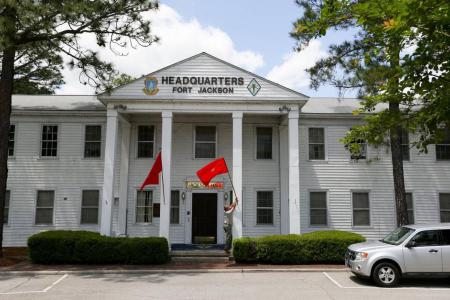
Fort Jackson post headquarters to be razed
When Fort Jackson celebrates its centennial in 2017 it will likely do so without its post headquarters that has stood along Jackson Boulevard since 1941.
The wooden, World War II-era headquarters building is slated for demolition, perhaps as soon as October, to make way for an amphitheater and green space, fort officials said. A replacement headquarters building is not planned.
The military and state officials determined neither building has historic significance.
Historic Columbia Foundation officials said they haven’t studied the two buildings. “But in light of the upcoming centennial of Camp Jackson, later known as Fort Jackson, it would be most unfortunate to lose such an iconic structure associated with the installation’s earliest years,” said John Sherrer, Historic Columbia’s director of cultural resources.
The Army’s Installation Management Command “wants to get out of World War II wood buildings” in all of its bases, said Col. Mark Shade, Fort Jackson’s deputy commanding officer. “They are inefficient. They are not up to code. They are cold in the winter and hot in the summer.”
The command and garrison staff will be relocated to much newer and roomier space along Jackson Boulevard in a building that once housed the NCO Academy. The academy has moved to the former Army Recruiting and Retention School, which was transferred last year to Fort Knox, Ky.
The move allows the post and garrison commanders and their staff to be consolidated in the 41,700-square-foot building instead of scattered throughout the post.
The 12,200-square-foot headquarters building is across Jackson Boulevard from the Basic Combat Training Museum, a favorite attraction for the 5,000 or so family members who show up each week for graduation ceremonies.
Shade said that in addition to creating the amphitheater and green space, a section of Jackson Boulevard will be permanently closed to link the museum with the amphitheater. The theater will be used for family-related events.
Fort officials said the military’s Directorate of Public Works ran through the criteria for the headquarters to be listed as a historic building and determined that it didn’t qualify. The State Historic Preservation Office at the S.C. Department of History and Archives concurred.
In 1997, a cultural consultant determined that neither the headquarters building nor the 3,200-square-foot Dozier House was eligible for the National Register of Historic Places because of the numerous renovations through the years.
Post records show the headquarters has undergone about $487,000 of renovations, largely architectural changes done in 1985.
The state preservation office at the time agreed, Eric Emerson, director of the S.C. Department of History and Archives, said recently.
“This office thought neither was eligible due to a lack of (architectural) integrity,” said Emerson, who also serves as the state historic preservation officer. “They have been modified so much over the years that they no longer look like the original buildings.”
The Dozier House, for example, had renovations in 1928, 1960 and 1970.
While the headquarters building evokes some nostalgia, it wasn’t ideal as a workplace, say some who have served there.
Retired Col. Angelo Perri served in the building from 1970 to 1972 as a deputy director of personnel, deputy chief of staff and for a short time as acting chief of staff.
“The building was quaint, historical but totally inadequate to serve as a post headquarters for the commanding general,” Perri said. “We used to say the only thing holding it up was the termites holding hands.”

